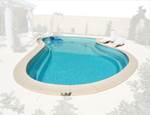Barrier coats in pool production
Barrier coats protect fiberglass swimming pools from invasive water-treatment chemicals.
Like inside-out composite boat hulls, fiberglass swimming pools must perform structurally and cosmetically, resisting the mechanical rigors of shipping and installation. The pool’s gel coated inner surface must withstand prolonged exposure to water treatment chemicals and sunlight.
“A swimming pool is a tough environment for any material,” says gel coat expert David Higgins of HK Research Corp. (Hickory, N.C.). “Most owners, unfortunately, don’t keep their treatment chemicals balanced, and it’s hard on the gel coat, as is UV exposure.” Although gel coat resins are reasonably chemical-resistant, chlorine in particular is caustic, he adds. And although today gel coat promoter and additive chemistries improve long-term durability, cobalt, for example, can react with chlorine and turn brown, a condition known as cobalt spotting.
To ensure the best result, Higgins recommends that pool manufacturers use a Novolac vinyl ester barrier coat. The inert resin forms a chemically resistant layer directly behind the 20-mil thick gel coat, preventing chemical reactions between the treated pool water that invariably seeps through the gel coat and the structural glass/polyester sprayup layer. The barrier also protects the gel coat from fiber print-through that would disrupt the gel coat’s cosmetics.
Like others in the industry, Higgins sees a trend toward darker gel coat colors in pools. HK’s High Definition gel coats, which include many dark hues, contain different color flecks, including silver, that not only contribute to an attractive finish, but also help to minimize the visual effect of fading, which can occur with solid-color gel coats, Higgins says.
Related Content
-
Materials & Processes: Composites fibers and resins
Compared to legacy materials like steel, aluminum, iron and titanium, composites are still coming of age, and only just now are being better understood by design and manufacturing engineers. However, composites’ physical properties — combined with unbeatable light weight — make them undeniably attractive.
-
Sulapac introduces Sulapac Flow 1.7 to replace PLA, ABS and PP in FDM, FGF
Available as filament and granules for extrusion, new wood composite matches properties yet is compostable, eliminates microplastics and reduces carbon footprint.
-
The state of recycled carbon fiber
As the need for carbon fiber rises, can recycling fill the gap?













